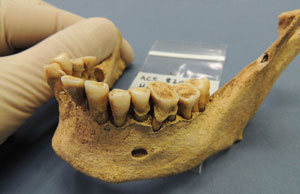A study of the evolution of our teeth over the last 7,500 years shows
that humans today have less diverse oral bacteria than historic
populations, which scientists believe have contributed to chronic oral
diseases in post-industrial lifestyles.
The researchers, from the University of Adelaide's Australian Centre for
Ancient DNA (ACAD), the University of Aberdeen (Dept of Archeology),
Scotland, and the Wellcome Trust Sanger Institute, Cambridge, England,
published their study in
Nature Genetics.
The authors say that analyzing the DNA of calcified bacteria on the
teeth of humans throughout modern and ancient history "has shed light on
the health consequences of the evolving diet and behavior from the
Stone Age to modern day".
The scientists explained that
there were negative changes in oral
bacteria as our diets altered when we moved from being hunter-gatherers
to farmers. Further changes were observed when humans started
manufacturing food during the Industrial Revolution.
Study leader Professor Alan Cooper, ACAD Director, said, "This is the
first record of how our evolution over the last 7500 years has impacted
the bacteria we carry with us, and the important health consequences."

The introduction of processed sugar may have completely changed the composition of oral bacteria in humans.
"Oral bacteria in modern man are markedly less diverse than historic
populations and this is thought to contribute to chronic oral and other
disease in post-industrial lifestyles."
The scientists extracted DNA from calcified dental plaque (tartar) from
34 prehistoric human skeletons from northern Europe. They examined the
changes in the nature of oral bacteria that were first present in
prehistoric hunter-gatherers, through to the Bronze Age when farming
became established, then to Medieval times and finally to the Industrial
Revolution and later.
Dr Christina Adler, lead author, who was a PhD student at the University
of Adelaide during the study, said "Genetic analysis of plaque can
create a powerful new record of dietary impacts, health changes and oral
pathogen genomic evolution, deep into the past." Dr. Adler now works at
the University of Sydney.
The modern mouth exists in a permanent disease state
Professor Cooper said:
"The composition of oral bacteria changed markedly with the
introduction of farming, and again around 150 years ago. With the
introduction of processed sugar and flour in the Industrial Revolution,
we can see a dramatically decreased diversity in our oral bacteria,
allowing domination by caries-causing strains. The modern mouth
basically exists in a permanent disease state."
Professor Cooper has been working with Professor Keith Dobney from the
University of Aberdeen on this for the last 17 years. Professor Dobney
said "I had shown tartar deposits commonly found on ancient teeth were
dense masses of solid calcified bacteria and food, but couldn't identify
the species of bacteria. Ancient DNA was the obvious answer."

Scientists examined tartar deposits found on ancient teeth in their study. (Photo: Alan Cooper/University of Adelaide)
Prof. Dobney explained that this study provides a completely new window
on how human populations lived and died in the past. If we know the real
genetic history of diseases humans still suffer from today, scientists
might better understand them, and even treat them more effectively.
"Being able to track them through time has huge implications for
understanding the origins and history of human health - making the
archaeological record extremely relevant and important to modern-day
medics and geneticists," Dobney added.
In an Abstract in
Nature Genetics, the authors wrote that "modern
oral microbiotic ecosystems are markedly less diverse than historic
populations, which might be contributing to chronic oral (and other)
disease in postindustrial lifestyles."
It was not until 2007 that the team could control background levels of
bacterial contamination properly. This became possible when ACAD's
super-clean labs and stringent decontamination and authentications
protocols became available.
The scientists are now expanding their studies geographically and
chronologically, and including other species, such as Neanderthals.
There is some evidence that
beeswax was used 6,500 ago in dentistry, scientists from Abdus Salam International Centre for Theoretical Physics, Italy, explained in the open access journal
PLoS ONE on 19th September, 2012.






